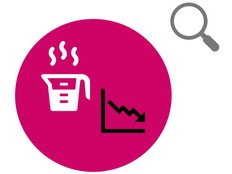Paso 1: Preparación
¿Qué es?
Investiga materiales para ver si son transparentes, translúcidos u opacos usando una linterna y dos BBC micro:bits.
Este proyecto ha sido desarrollado en colaboración con White Rose Science para profesores de ciencias y permite a los estudiantes explorar las propiedades de los materiales y el efecto de colocar objetos en el camino de un haz de luz. Los estudiantes también pueden aprender sobre el uso de secuencias, variables y bucles en un programa informático.
Este video explica cómo funciona el proyecto y cómo realizar el experimento.
Cómo funciona
- El mismo código se usa en ambas micro:bits.
- Una micro:bit se coloca dentro de una caja mientras la otra se queda contigo.
- Cubre el extremo abierto de la caja con los diferentes materiales que estás probando y alumbra con una linterna a través de los materiales hacia el interior de la caja.
- La micro:bit dentro de la caja mide la luz que penetra el material y envía sus mediciones por radio a la micro:bit que está en la habitación.
- La micro:bit de la habitación muestra las lecturas de luz.
- Las lecturas van desde 0 (completamente oscuro) a 100 (muy brillante). Las lecturas más bajas sugieren opacidad y las más altas sugieren transparencia.
Lo que necesitas
- Una linterna.
- Una caja larga y estrecha, un vaso de papel o un tubo de cartón sin tapa.
- Materiales para probar, como un trozo de papel, plástico de burbujas, fieltro y una funda de plástico transparente, cada uno lo suficientemente grande como para cubrir el extremo abierto de la caja.
- dos micro:bits
- Al menos un paquete de baterías con pilas nuevas.
Paso 2: Investigar
- Descarga el archivo .HEX y carga el código en ambas micro:bits. Para este proyecto, no necesitas escribir el código para realizar el experimento, pero si te interesa programarlo, visita la sección Paso 3: Codifícalo a continuación.
- Conecta al menos, un paquete de pilas a una micro:bit. Coloca la micro:bit con el paquete de baterías en el fondo de la caja con los LEDs hacia arriba. Ubica el paquete de baterías debajo de la micro:bit para que no obstruya la luz.
- Enciende la linterna y sostenla en la abertura de la caja, pero no dentro de ella. Presiona el botón B en la micro:bit que tienes en la habitación para medir el nivel de luz en el fondo de la caja. Anota la lectura. Para mayor precisión, completa la prueba tres veces y calcula el promedio. Esta será tu lectura de control, la cual debes tomar como referencia, ya que tus lecturas máximas de luz dependerán de la intensidad de tu linterna.
- Ahora, coloca un trozo del material que estás probando sobre el extremo de la caja. Alumbra con la linterna a través del material, manteniéndola en la misma posición con respecto a la caja que antes. Presiona nuevamente el botón B y anota la lectura.
- Repite el proceso para otros materiales.
- Compara tus resultados. ¿Son lo que esperabas?
Tips
- Es recomendable realizar esta investigación con otra persona, ya que puede ser difícil sujetar la linterna y el material mientras se toman las lecturas.
- Si obtienes lecturas inesperadas de 0 durante la investigación, intenta desconectar y volver a conectar los paquetes de baterías o presiona el botón de reinicio en la parte posterior de las micro:bits.
- Algunos materiales pueden dejar pasar algo de luz que la micro:bit no detecta. Coloca la linterna directamente sobre la muestra de material para obtener los mejores resultados.
- Los números de dos dígitos se desplazarán por la pantalla LED de la micro:bit. Anima a los estudiantes a practicar la lectura de números en la pantalla antes del experimento.
Realizando este experimento en una clase o club de programación
Si estás realizando este experimento en una clase o club de programación, cada par de micro:bits debe tener números de grupo de radio diferentes. Esto asegurará que cada micro:bit receptora reciba las lecturas de la micro:bit transmisora correcta.
Abre el proyecto en Microsoft MakeCode e introduce un número único en el bloque radio establecer grupo, luego descarga ese archivo HEX en las dos micro:bits. Mantenlos unidos con una banda elástica o en una bolsa pequeña. Repite el proceso para cada par de micro:bits que se utilicen en la clase.
Paso 3: prográmalo
Mira este video para saber cómo codificar el proyecto:
Si estás interesado en modificar el código para este proyecto, haz clic en uno de los botones a continuación:
This content is published under a Creative Commons Attribution-ShareAlike 4.0 International (CC BY-SA 4.0) licence.



